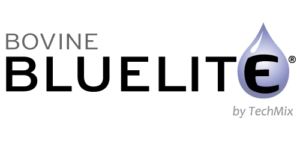Reproduction and Heat Stress
The detrimental impact of physiologic responses
In periods of heat stress, cows readily lose water and nutrients required for optimal body function and performance. The combination of heat and humidity can compromise a cow’s ability to dissipate excess body heat. Cooling systems and heat abatement programs are important for cooling the outside of the cow. However, cooling the cow from the outside is not sufficient to negate the physiologic consequences of heat stress. Cooling the cow from the inside may help maintain her production and reproductive performance.
Get your copy of
Reproduction and Heat Stress
Defining heat stress and its impact
Heat stress occurs when a cow’s ability to dissipate heat is exceeded by heat generated from metabolic heat production and heat gain from environmental sources. Humidity is also a contributing factor to heat stress conditions and the Temperature Humidity Index (THI) is the primary method of measurement.
A wide range of physiologic and behavioral changes result from heat stress (Figure 2). Reductions in reproductive performance of dairy and beef cows during the summertime have been well documented and can be particularlycostly to the producer. Lactating dairy cows are especially prone to metabolic heat increases due in part to their high energy diet, high feed intake, and the metabolic activity required for digestion and milk production. These factors lead to excessive core body temperature during heat stress periods and are reflected in lower seasonal conception rates between 10-20% across the US; higher in sub-tropical and desert regions (Figure 3). Dairy producers often value a pregnancy greater than $300 (265 €) and fewer pregnancies occur during times of heat stress resulting in significant financial loss. Therefore, it is important to manage heat stress events to either prevent heat stress from occurring or supporting a quick recovery.
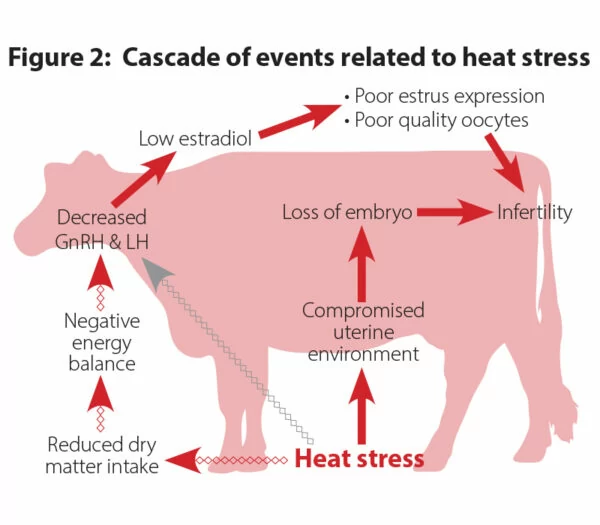
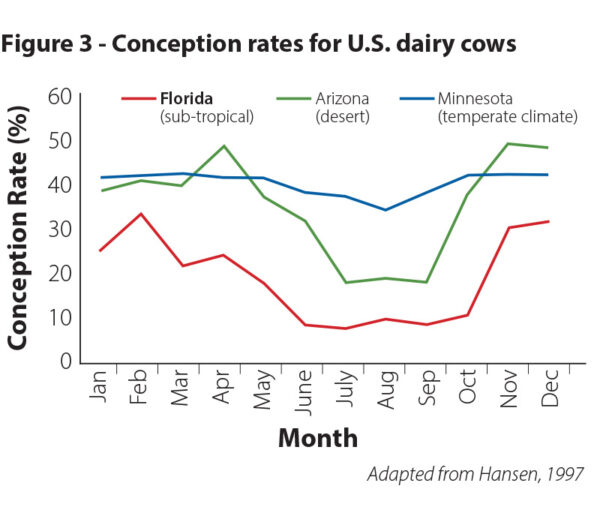
How heat stress affects reproduction.
Dairy cow reproductive performance declines during phases of heat stress in three ways. The estrus intensity lessens during heat stress so heat detection becomes more difficult. Secondly, fertility is reduced; and finally, the survival of early embryos is compromised.
Every mammal has homeokinetic mechanisms that work to regulate physiology during stress events like heat stress. One of these mechanisms for the dairy cow is the redirection of blood flow from the core to the periphery for cooling. This process can lead to cellular nutrient loss which in turn may hinder fetal development. Another adaptive mechanism is to regulate body temperature by reducing feed intake. It is well known that digestion generates heat, so in theory reduced feed intake may reduce excessive body heat gain.
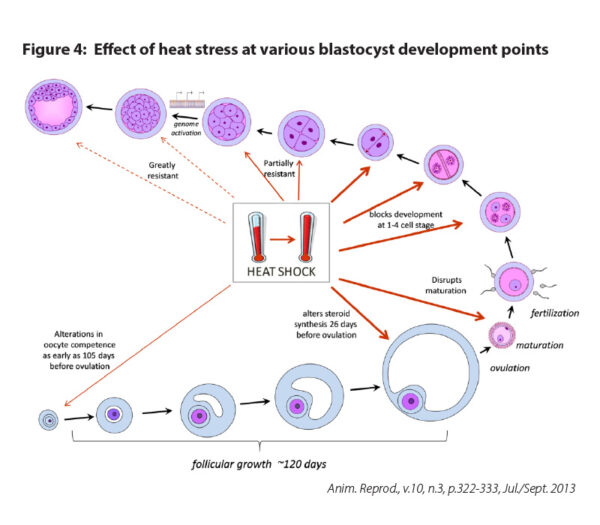
However the reduction in feed intake can also lead to significant reductions in energy intake and nutrient availability. If the reduction is great enough it can even lead to increased risk of acidosis. This drop in feed intake can also impact cyclicity, establishment of pregnancy and fetal development.
Elevated body temperature during heat stress negatively affects the entire reproductive process. (Figure 4). Reproductive oocyte cells are the building block cells required for reproduction. Elevated core body temperature is detrimental to these cells during the first 5-6 days of development. Heat stress that coincides in timing with oocyte maturation and ovulation can result in embryos that are more likely to develop slowly, abnormally (Putney et al. 1989), and have shown a reduced ability to develop to the blastocyst stage after fertilization (Zeron et al., 2001; Al-Katanani et al., 2002). Additionally, elevated body temperatures contribute to oocyte cell death further reducing opportunities for pregnancy success.
Heat stress is also detrimental to the follicle that encloses the oocyte cell and can lead to more small and medium sized follicles and reduced dominance. There is a close correlation between these follicle alterations and changes in the endocrine system resulting in reduced concentrations of estradiol—a powerful and natural ovarian and placental estrogen that works to prepare the uterus for implantation of the fertilized ovum. Principal effects of lower estradiol levels include impaired estrus duration and intensity, and increased incidence of anestrus (Gwazdauskas et al., 1981; Wolfenson et al., 1988). High air temperatures 10 days before estrus are shown to be associated with low fertility (Al-Katanani et al. 1999) but even after pregnancy is established, there is a significant pregnancy loss in dairy cattle: about 10% of pregnancies at Day 40-50 resulting in fetal loss (Garcia-Ispierto et al., 2006).
When viewed directly with the THI, the correlation between temperature/humidity and pregnancy loss is very clear (Figure 5) and collectively all these changes and events reduce the probability of conception rate and fetal survival.
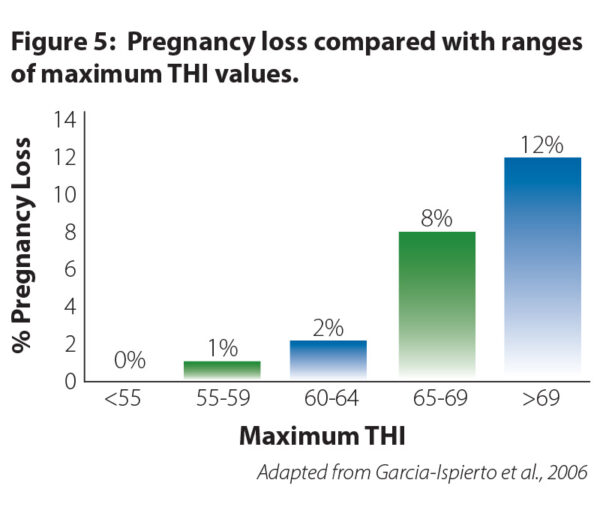
heat stress and nutrition
Nutritional deficits contribute to prolonged postpartum anestrus. The interaction with genetic, environmental, or management factors also influence the duration of anestrus. There is an inverse relationship between energy balance and the time ovarian activity resumes postpartum such that inadequate nutrient intake results in loss of weight and body condition score, and finally cessation of estrous cycles. Prolonged postpartum anestrus is a main factor limiting reproductive efficiency. During anestrus ovulation does not occur despite ovarian follicular development, because growing follicles do not mature… largely due to inadequate nutrient availability.
Cooling cows from the inside out
The negative effects of heat stress on cows is wide ranging but reproduction effects alone can have a significant impact on a dairy. Heat abatement solutions are necessary – such as soakers, fans, misters, and shade, but providing nutritional solutions are equally valuable. Nutritional solutions during heat stress events should include electrolytes, key vitamins and nutrients. Encouraging water and feed intake can help maintain nutrient and energy balance, proper rumen pH levels and some nutritional components, such as betaine, are shown to provide a cooling effect with vaginal temperatures of treated cows being lower than non-treated. What cannot be overlooked however, is hydration – providing clean water in abundance. Proper hydration supports cellular health which is required to maintain health and reproduction.

